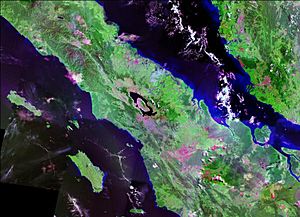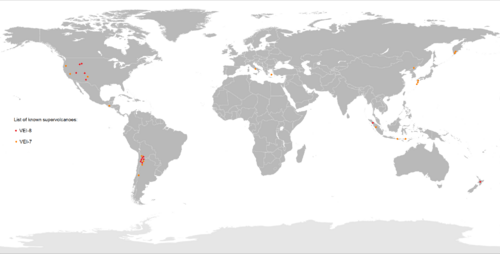Supervolcano facts for kids

A supervolcano is a special type of volcano. It can cause a huge volcanic eruption that throws out more than 1,000 cubic kilometers (240 cubic miles) of material. This is thousands of times bigger than most volcanic eruptions we know about!
Supervolcanoes form when hot, melted rock called magma rises from deep inside the Earth. It gets trapped under the Earth's crust and can't break through. As more and more magma collects, the pressure builds up. Eventually, the crust can't hold it anymore, leading to a massive explosion.
Even though these eruptions are rare, they can cover huge areas with lava and volcanic ash. A super-eruption can even change the world's weather for a long time. It could trigger a small ice age and might even cause many species to die out.

Contents
What is a Supervolcano?
The word "supervolcano" was first used in a BBC science TV show called Horizon in 2000. It was created to describe these incredibly powerful eruptions.
Scientists who study volcanoes, called volcanologists, don't usually use "supervolcano" in their scientific reports. This is because the term can mean different things. However, since 2003, they have started using it when talking to the public. Sometimes, a similar term, megacaldera, is used for very large calderas. An example is the Blake River Megacaldera Complex in Canada.
How Powerful are Super-Eruptions?
Scientists use the Volcanic Explosivity Index (VEI) to measure how big a volcanic eruption is. It's like a scale for volcano power! The VEI is a logarithmic scale. This means that each step up on the scale (like from VEI 7 to VEI 8) means the eruption was ten times more powerful.
VEI 7 or VEI 8 eruptions are so strong that they don't form tall, cone-shaped volcanoes. Instead, they create large, bowl-shaped holes in the ground called calderas. This happens because when the magma erupts, the ground above the empty magma chamber collapses downwards.
Famous Super-Eruptions
Scientists have found at least 60 eruptions that were VEI 8. Here are some of the most well-known ones:
| Name | Location | Years ago (approx.) | Ejecta bulk volume (approx.) |
|---|---|---|---|
| Flat Landing Brook Formation | New Brunswick, Canada | 466,000,000 | 2,000–12,000 km3 |
| Wah Wah Springs | Utah, United States | 30,600,000 | 5,500–5,900 km3 |
| La Garita Caldera | Colorado, United States | 27,800,000 | 5,000 km3 |
| Lake Toba | Sumatra, Indonesia | 74,000 | 2,800 km3 |
| Atana Ignimbrite | Antofagasta, Chile | 4,000,000 | 2,500 km3 |
| Huckleberry Ridge eruption | Idaho, United States | 2,100,000 | 2,450–2,500 km3 |
| Taupo Nui a tia | North Island, New Zealand | 340,000 | 2,000 km3 |
| Heise Volcanic Field | Idaho, United States | 4,500,000 | 1,800 km3 |
| Heise Volcanic Field | Idaho, United States | 6,000,000 | 1,500 km3 |
| Cerro Guacha | Sur Lípez, Bolivia | 5,700,000 | 1,300 km3 |
| Mangakino Caldera | North Island, New Zealand | 1,080,000 | 1,200 km3 |
| Oruanui eruption | North Island, New Zealand | 26,500 | 1,170 km3 |
| Cerro Galán | Catamarca, Argentina | 2,500,000 | 1,050 km3 |
| Lava Creek eruption | Idaho, Montana, and Wyoming, United States | 640,000 | 1,000 km3 |
Related Pages
Images for kids
-
Satellite image of San Salvador, El Salvador and the Lake Ilopango caldera. This volcano is thought to have caused extreme weather events around 535–536 AD.
See also
 In Spanish: Supervolcán para niños
In Spanish: Supervolcán para niños




